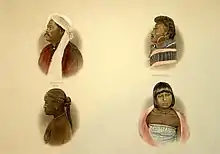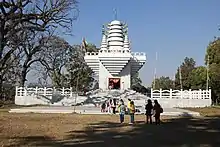Ancient Kangleipak
Ancient Kangleipak was an ancient, lesser known civilisation, concentrated along the central plains of the modern day Kangleipak (Manipur), India.[1][2][3][4]
The Kangla served as the foremost capital city of this realm from the 15th century AD. up to the late 19th century AD.[5]


History

Geography
The territory of this realm is mountainous and thereby, ancient Kangleipak consists of several smaller region each with its own dialect, cultural peculiarities, and identity.[4][6]At one time during the reign of Meidingu Khagemba the territory of Kangleipak(Manipur) stretched upto the present Yunan Province of modern day China.[7] Kabaw valley in Mayanmar was also a part of Manipur until the then Prime Minister Jawaharlal Nehru India gifted it to Myanmar on his visit to Manipur in 1952.[8] Thibomei(now Kohima) was also once annexed by the then King Gambhir Singh.[9]
In fact, there were seven independent kingdoms ruled by the seven clan dynasties in this realm. These seven principalities had their own capital cities.
| Capital cities | Latin transliteration | Respective kingdoms | Latin transliteration | Ruling dynasties | Latin transliteration |
|---|---|---|---|---|---|
| ꯏꯝꯐꯥꯜ ꯀꯪꯂꯥ | Imphal Kangla | ꯏꯝꯐꯥꯜ | Imphal | ꯅꯤꯡꯊꯧꯖꯥ (ꯃꯉꯥꯡ) | Ningthouja (Mangang) |
| ꯂꯨꯋꯥꯡꯁꯪꯕꯝ ꯀꯪꯂꯥ | Luwangsangbam Kangla | ꯂꯨꯋꯥꯡꯁꯪꯕꯝ | Luwangsangbam | ꯂꯨꯋꯥꯡ | Luwang |
| ꯅꯣꯡꯌꯥꯢ ꯂꯩꯀꯣꯢꯄꯨꯡ | Nongyai Leikoipung | ꯃꯌꯥꯡ ꯏꯝꯐꯥꯜ | Mayang Imphal | ꯈꯨꯃꯟ | Khuman |
| ꯀꯣꯡꯕ ꯃꯔꯨ ꯀꯪꯂꯥ | Kongba Maru Kangla | ꯀꯣꯡꯕ ꯃꯔꯨ | Kongba Maru | ꯑꯉꯣꯝ | Angom |
| ꯃꯣꯢꯔꯥꯡ ꯀꯪꯂꯥ | Moirang Kangla | ꯀꯦꯀꯦ ꯃꯣꯢꯔꯥꯡ | Keke Moirang | ꯃꯣꯢꯔꯥꯡ ꯁꯂꯥꯢ | Moirang Salai |
| ꯇꯥꯛꯅꯈꯥ ꯄꯨꯔꯨꯛ ꯁꯧꯄꯤ ꯀꯪꯂꯥ | Taknakha Puruk Soupi Kangla | ꯇꯥꯛꯅꯈꯥ ꯄꯨꯔꯨꯛ ꯁꯧꯄꯤ | Taknakha Puruk Soupi | ꯈꯥ ꯉꯥꯟꯄ | Kha Nganpa |
| ꯂꯩꯁꯪꯈꯣꯡ ꯀꯪꯂꯥ | Leishangkhong Kangla | ꯂꯩꯁꯪꯈꯣꯡ | Leishangkhong | ꯁꯂꯥꯢ ꯂꯩꯁꯥꯡꯊꯦꯝ | Salai Leishangthem |
Language
The Ancient Meitei language (early form of the modern Meitei language) had a wide array of Meitei scriptures (Puya (Meitei texts)), of numerous topics, written in the archaic Meitei script.[10][11] One of the oldest scriptures is the Wakoklon Heelel Thilen Salai Amailon Pukok Puya, written in 1398 BC (verified by the National Archives of India, New Delhi).[12]

Culture

Daily life
Most people of ancient Kangleipak were farmers tied to their lands. Their dwellings were restricted to immediate family members.
Architecture
The ancient architectural designs of common houses were believed to be sustainable, eco friendly and affordable. It gives a cooling effect during hot summer and a warming effect during chilling winter.[13]
Religious beliefs

The ancient religion of the indigenous ethnicities of the hills and the plains is the Sanamahism. The abstract concept of the space time entity is the ultimate God creator of the universe.[14] Beliefs in the divine and in the afterlife were ingrained in ancient Kangleipak from its inception. The ancient rulers were based on the divine right of kings.[14]
Military

The Ancient Meitei military ran un the Lallup system. Lal-lup system (literally, Lal means war; lup means club or association or organization) was a predominant system in ancient Kangleipak. According to the system, every men of indigenous ethnicity of above 16 years of age was a member.[14]
Related pages
References
- Press, Imphal Free. "Ancient Name Of Manipur – KanglaOnline".
- Gurumayum, William. "Is 32,000 years of Meitei civilization a sign of tribalism? - Imphal Times". www.imphaltimes.com. Archived from the original on 2022-01-16. Retrieved 2023-02-18.
- "Review Kangleipak The Cradle Of Man". e-pao.net.
- "A Brief history of the Meiteis of Manipur". themanipurpage.tripod.com.
- "Kangla The ancient Capital of Manipur". www.e-pao.net.
- "Discovery of Kangleipak 8". e-pao.net.
- "HistoryFacts : Khagemba- conqueror of the Chinese". HINDUISM AND SANATAN DHARMA. 2021-09-16. Retrieved 2023-09-16.
- "Over to Dr RK Ranjan". Imphal Free Press. Retrieved 2023-09-16.
- "Kohima Stone Inscription", Wikipedia, 2023-03-12, retrieved 2023-09-16
- "The Puya and Cheitharol Kumbaba". e-pao.net.
- "A Brief history of the Meiteis of Manipur". themanipurpage.tripod.com.
- http://paochelsalaitaret.net/puya/puyaproof.pdf
- "Scientific Principles of Ancient Manipuri Yumjao House and its Courtyard By Khwairakpam Gajananda". www.e-pao.net.
- "Discovery of Kangleipak 2". e-pao.net.